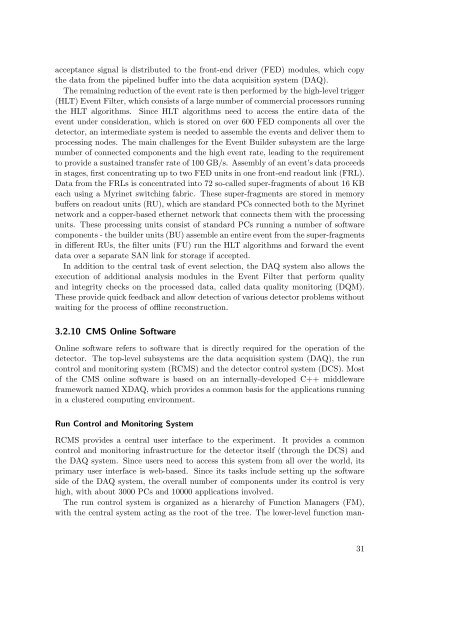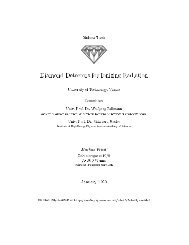Create successful ePaper yourself
Turn your PDF publications into a flip-book with our unique Google optimized e-Paper software.
acceptance signal is distributed to the front-end driver (FED) modules, which copythe data from the pipelined buffer into the data acquisition system (DAQ).The remaining reduction of the event rate is then performed by the high-level trigger(HLT) Event Filter, which consists of a large number of commercial processors runningthe HLT algorithms. Since HLT algorithms need to access the entire data of theevent under consideration, which is stored on over 600 FED components all over thedetector, an intermediate system is needed to assemble the events and deliver them toprocessing nodes. The main challenges for the Event Builder subsystem are the largenumber of connected components and the high event rate, leading to the requirementto provide a sustained transfer rate of 100 GB/s. Assembly of an event’s data proceedsin stages, first concentrating up to two FED units in one front-end readout link (FRL).Data from the FRLs is concentrated into 72 so-called super-fragments of about 16 KBeach using a Myrinet switching fabric. These super-fragments are stored in memorybuffers on readout units (RU), which are standard PCs connected both to the Myrinetnetwork and a copper-based ethernet network that connects them with the processingunits. These processing units consist of standard PCs running a number of softwarecomponents - the builder units (BU) assemble an entire event from the super-fragmentsin different RUs, the filter units (FU) run the HLT algorithms and forward the eventdata over a separate SAN link for storage if accepted.In addition to the central task of event selection, the DAQ system also allows theexecution of additional analysis modules in the Event Filter that perform qualityand integrity checks on the processed data, called data quality monitoring (DQM).These provide quick feedback and allow detection of various detector problems withoutwaiting for the process of offline reconstruction.3.2.10 CMS Online SoftwareOnline software refers to software that is directly required for the operation of thedetector. The top-level subsystems are the data acquisition system (DAQ), the runcontrol and monitoring system (RCMS) and the detector control system (DCS). Mostof the CMS online software is based on an internally-developed C++ middlewareframework named XDAQ, which provides a common basis for the applications runningin a clustered computing environment.Run Control and Monitoring SystemRCMS provides a central user interface to the experiment. It provides a commoncontrol and monitoring infrastructure for the detector itself (through the DCS) andthe DAQ system. Since users need to access this system from all over the world, itsprimary user interface is web-based. Since its tasks include setting up the softwareside of the DAQ system, the overall number of components under its control is veryhigh, with about 3000 PCs and 10000 applications involved.The run control system is organized as a hierarchy of Function Managers (FM),with the central system acting as the root of the tree. The lower-level function man-31












